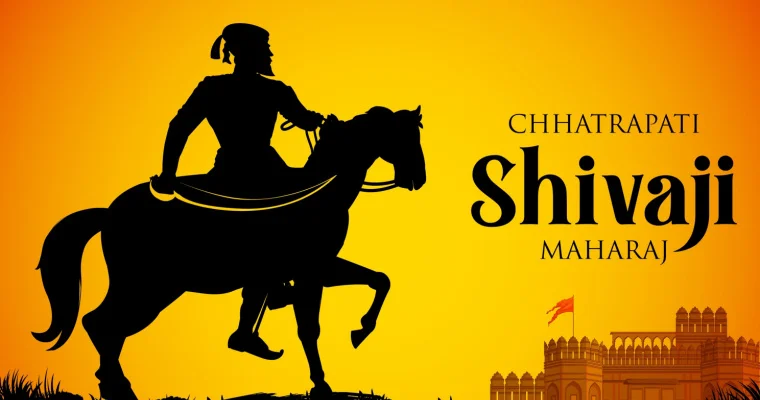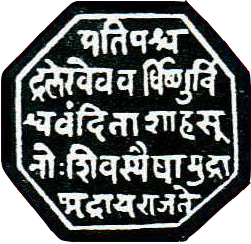Chhatrapati Shivaji Maharaj

Chhatrapati Shivaji Maharaj was a prominent Maratha warrior-king and the founder of the Maratha Empire in western India during the 17th century. Born in 1630, Chhatrapati Shivaji Maharaj was the son of Shahaji Bhonsle, a Maratha general, and Jijabai, a devout and courageous woman. He was born at the hill fortress of Shivneri, near the city of Junnar in Pune district of Maharashtra.
Chhatrapati Shivaji Maharaj, also spelled as Sivaji, came into the world on February 19, 1630, at Shivneri, a hill fort situated in Junnar near Pune, formerly known as Poona. Born into a family with a bureaucratic background, his father, Shahji Bhonsale, was a distinguished Maratha general in the army of the Bijapur Sultanate, while his mother, Jijabai, was a devoted follower of religion. Shivaji Maharaj went on to become the founder of the illustrious Maratha kingdom in India, showcasing his exceptional courage and leadership as one of the most remarkable rulers of the 17th century.

Early Life:
Chhatrapati Shivaji Maharaj, the founder of the Maratha kingdom in India, established a realm that prioritized religious tolerance and the effective integration of Brahmans, Marathas, and Prabhus for its security.
Shivaji Maharaj, descended from a line of distinguished nobles, displayed exceptional bravery and engaged in numerous wars to unify India during a period when the country was fragmented under Muslim rule. The Mughals held sway in the north, while the Muslim sultans of Bijapur and Golconda governed the southern regions.
Shivaji Maharaj’s ancestral estates were located in the Deccan region, under the rule of the Bijapur sultans. Witnessing the oppression of Muslim rulers and the persecution of Hindus in the area deeply saddened him. By the age of 16, he had resolved to be the catalyst for Hindu freedom, a conviction that remained steadfast throughout his entire life.
Life History of Chhatrapati Shivaji Maharaj
Chhatrapati Shivaji Maharaj, the architect of the Maratha kingdom in India, founded a realm whose security was deeply rooted in religious tolerance and the harmonious integration of Brahmans, Marathas, and Prabhus.
Descended from a distinguished line of nobles, Shivaji Maharaj displayed remarkable bravery, engaging in numerous wars to unify India during a period of division under Muslim rule. At the time, the Mughals held sway in northern India, while the Muslim sultans of Bijapur and Golconda governed the southern regions.
Chatrapati Shivaji Maharaj’s ancestral estates were located in the Deccan region under the rule of the Bijapur sultans. Witnessing the suppression of Muslim rulers and the persecution of Hindus deeply saddened him. Motivated by the distressing condition of his fellow Hindus, by the age of 16, he resolved to be the catalyst for Hindu freedom—a conviction that remained with him throughout his entire life.
Childhood and Early Life of Chhatrapati Shivaji Maharaj
He spent his formative years immersed in the study of both the Ramayana and the Mahabharata. Chhatrapati Shivaji Maharaj exhibited a profound curiosity for religious teachings, particularly those of Hinduism and Sufi Saints. His upbringing was overseen by his mother, Jijabai, and his mentor and administrator, Dadoji Kond Deo.
Following his father’s departure to Karnataka with his second wife Tukabai, Dadoji took on the responsibility of instructing Shivaji in various skills, including horse riding, archery, patta, and a range of combat techniques.
Growing up amidst the tumultuous landscape of 17th-century India, Shivaji witnessed the disarray of a nation divided under the rule of Muslim monarchs. The Mughals held sway in the north, while the Deccan region, where Shivaji’s ancestral estates lay, was under the dominion of the Bijapur sultans.
Catalyst for Change:
The young Shivaji Maharaj found himself deeply affected by the suppression of Muslim rulers and the persecution faced by Hindus in the Deccan region. The plight of his fellow Hindus stirred a profound sadness within him, and by the age of 16, he made a solemn resolve – to be the harbinger of Hindu freedom. This conviction, born out of empathy and a sense of responsibility, became the guiding force that would shape Shivaji’s destiny.
Early Military Exploits:
Shivaji’s journey to power was marked by audacious military campaigns. In 1645, he seized the Torna Fort, a pivotal moment that heralded the beginning of his efforts to establish a sovereign Maratha state. His strategic brilliance and innovative guerrilla warfare tactics soon became the stuff of legends.
Conquests of Chhatrapati Shivaji Maharaj
In the annals of Indian history, the name Chhatrapati Shivaji Maharaj resonates as a symbol of courage, valor, and strategic brilliance. The founder of the Maratha kingdom, Shivaji Maharaj, undertook a series of remarkable conquests that not only secured his legacy but also laid the foundation for one of the most formidable empires in Indian history.
I. Early Military Exploits:
Shivaji Maharaj’s military journey commenced with the conquest of strategic forts in the Western Ghats. In 1645, at the age of just 16, he seized the Torna Fort, marking the beginning of his relentless pursuit of a sovereign Maratha state. The subsequent years witnessed a string of victories as he strategically captured key forts such as Rajgad and Kondana.
II. Guerrilla Warfare and Naval Prowess:
Shivaji Maharaj was a master tactician, pioneering guerrilla warfare tactics that proved highly effective against the more substantial Mughal and Bijapur forces. His navy, equipped with Maratha warships, dominated the Konkan coastline, challenging European naval powers and securing crucial ports.
III. Fortifications and Strategic Control:
Recognizing the importance of a well-fortified kingdom, Shivaji Maharaj meticulously planned and executed the construction of forts across Maharashtra. The Raigad Fort, perched atop a hill, became the symbolic capital and a testament to his strategic foresight. Each fortification served as a stronghold, ensuring territorial control and safeguarding against external threats.
IV. Battles Against the Mughals and Adil Shah:
Shivaji’s confrontations with the Mughals, particularly Aurangzeb, are legendary. The Battle of Pratapgad in 1659, where he defeated the skilled Afzal Khan, showcased his tactical brilliance. Subsequently, his expeditions against the Adil Shahi Sultanate and the Battle of Kolhapur in 1675 further solidified Maratha influence in the Deccan.
V. Administrative Brilliance:
Beyond the battlefield, Shivaji Maharaj displayed remarkable administrative acumen. The establishment of the Ashta Pradhan (Council of Eight Ministers) exemplified his commitment to efficient governance. His policies promoted religious tolerance, a hallmark of the Maratha kingdom, fostering unity among Brahmans, Marathas, and Prabhus.
Chhatrapati Shivaji Maharaj’s conquests reverberate through history as a testament to his indomitable spirit and leadership. His ability to unify a fragmented land, coupled with strategic brilliance and administrative sagacity, ensured the longevity of the Maratha Empire. The legacy of Shivaji Maharaj endures as an inspiration for generations, encapsulating the essence of resilience and visionary leadership in the face of adversity.
Independent Sovereign
In the summer of 1674, Shivaji Maharaj orchestrated a grand enthronement ceremony, declaring himself an independent sovereign. The suppressed Hindu majority wholeheartedly embraced him as their esteemed leader. Over the next six years, he governed his realm through a council of eight ministers.
Despite his staunch devotion to Hinduism and being a proud defender of his religion, Chhatrapati Shivaji Maharaj took an unconventional step by ordering the reversion of two of his relatives, forcibly converted to Islam, back to Hinduism.
While both Christians and Muslims often sought to impose their faith forcefully, Shivaji Maharaj stood out by respecting the beliefs and safeguarding the religious sites of both communities. His administration included the service of not only Hindus but also many Muslims.
Following his coronation, one of his most notable campaigns unfolded in the south, where he formed alliances with local Sultans, thwarting the ambitious Mughal plan to extend their rule across the entire subcontinent.
Spouses of Chatrapati Shivaji Maharaj
1. Saibai (Sai Bai):
Saibai was Shivaji Maharaj’s first wife and the mother of his eldest son, Sambhaji Maharaj.
Sambhaji later succeeded his father as the Chhatrapati of the Maratha Kingdom.
2. Soyarabai (Soyra Bai):
Soyarabai was another important wife of Shivaji Maharaj and the mother of his second son, Rajaram.
Rajaram became the Chhatrapati after the demise of Sambhaji.
3. Putalabai (Kashibai):
Putalabai, also known as Kashibai, was married to Shivaji Maharaj and bore him a son named Shahaji.
Shahaji did not play a significant role in the political affairs of the Maratha Empire.
4. Sakvarbai:
Sakvarbai was one of Shivaji’s wives, but historical details about her and her children are relatively limited.
5. Other Marriages:
Shivaji Maharaj had additional wives, and his marriages were often strategic alliances with noble families to strengthen political ties.
Children of Chhatrapati Shivaji Maharaj:
Sambhaji Maharaj: Eldest son of Shivaji Maharaj, succeeded him as the Chhatrapati.
Rajaram Maharaj: Second son, became Chhatrapati after the death of Sambhaji.
Shahaji Maharaj: Son of Putalabai, did not play a prominent role in politics.
Others: Shivaji Maharaj had several other sons and daughters, though historical records may not provide extensive details about all of them.
How Did Shivaji Maharaj Die?
Chhatrapati Shivaji Maharaj died on April 3, 1680, at the Raigad Fort. The exact cause of his death has been a subject of historical debate and speculation, and there are different accounts provided by historical records.
The most widely accepted historical account suggests that Shivaji Maharaj fell seriously ill and passed away due to complications related to an acute case of dysentery or an abscess in the urinary bladder. This version is supported by the writings of contemporary historians such as Khafi Khan and French traveler François Martin.
According to some historical accounts, Shivaji Maharaj’s health deteriorated rapidly, and despite the efforts of his physicians, he succumbed to his illness. His death marked the end of an era and led to the succession of his younger son, Rajaram, as the next Chhatrapati of the Maratha Empire.
It’s important to note that historical events from this period are sometimes clouded by varying narratives, and while the dysentery theory is widely accepted, there may still be some uncertainties about the exact circumstances of Shivaji Maharaj’s demise.
Family tree of Chatrapati Shivaji Maharaj
